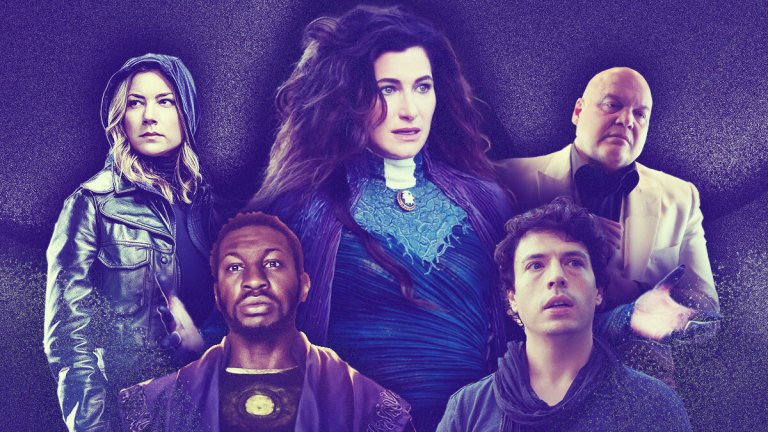Marvel’s Disney+ Shows Have a Weird Villain Problem
An odd trend has evolved with Marvel's Disney+ shows. Is it creating a real problem for their villains?

This article contains MCU spoilers
Marvel has just concluded their 8th show on Disney+, rounding out the Phase 4 experiment in a definitive way. While fans await the next stage of the Marvel Cinematic Universe’s plans for the streaming service, it’s a great time to reflect on the tropes and trends that are beginning to emerge as Kevin Feige’s studio grapples with a slightly different medium.
The need for a big bad has driven every series in the superhero genre. It’s rare to see a show from Marvel or indeed DC that doesn’t settle on a major antagonist to steer the narrative, rather than consistently sticking to a villain of the week formula with shorter arcs. However, while Marvel Studios has maintained that formula for their Disney+ shows, it’s also become commonplace to see the foe actually revealed in the conclusive episodes. It seems that Marvel wants its final boss to be as final as it possibly can be. But is this damaging the shows themselves?
The Marvel Norm
Before analyzing the way in which Marvel has utilized their villains in the TV shows, it’s pretty useful for us to look at the precedent that’s already been set by Marvel’s movies and pre-Disney+ television series.
The MCU and its extended releases have often been praised for their adaptations of classic foes from the comic books. The movies follow the general conventions of any major action film, revealing the threat in the first act, creating a moment of conflict that knocks the heroes back in the second, before the foe meets their comeuppance in the finale. That’s been played with a few times, adding in secondary antagonists, or perhaps giving the villain the win as was the case with Thanos, but ultimately the arcs remain relatively the same.
That’s not a criticism, as the formula works. There’s been very few times where a twist has been specifically pulled off to change the status quo; Ikaris’ turn in Eternals is one of the only examples that comes to mind. The benefit to this structure is that fans get a chance to see a villain properly develop, whether it’s a greater understanding of their motivations, or even a demonstration of their origins.
The pre-Disney+ shows pretty much followed the same path. Kingpin was such a beloved part of Daredevil because the character was essentially treated as a secondary lead. The same can be said for the villains that emerged in seasons of Agents of S.H.I.E.L.D. or perhaps even The Runaways. These shows didn’t wait until their penultimate episode to finally indicate who the hero was supposed to be fighting against. Instead, they took full advantage of the character that they had the opportunity to develop and jumped right in.
The Disney+ Trend
The Disney+ shows stand in stark contrast to what has become the norm for the genre. It’s hard to imagine turning on The Defenders for the first time without knowing that the group will be battling The Hand for instance. Yet, time and again, the revelation of who is behind a sinister plot is kept until the final few episodes. That often means that the one-on-one confrontation between the leading hero and their nemesis is exclusively held for the finale.
Marvel has often described their streaming shows as structurally similar to the films; as if they are just an extended feature length production. But even the movies don’t often use this method to adapt their villains. Red Skull and Captain America came to blows far before their final confrontation. The Guardians and the Kree did battle at the behest of Drax’s poor planning before their fight above Xandar. And yet, this newly found tradition has been cemented in a lot of these recent releases.
The Culprits
WandaVision was the initial Disney+ Marvel Studios show to launch. It was fun, played on a range of classic sitcoms and boosted plenty of supporting characters into major positions. But fans will also remember the brilliant twist that ‘it was Agatha all along,’ acting as the cliffhanger to the penultimate episode. Scarlet Witch and her newly established foe would battle briefly in the finale and that was the end of that.
That was just the start, though. Falcon and the Winter Soldier quickly followed and while U.S.Agent and the Flag Smashers were the well-defined antagonists driving the series, the identity of the Power Broker would be a final, slightly lacklustre reveal, with Sharon Carter getting unmasked. Loki followed, with He Who Remains stepping up to the mildly villainous plate… you guessed it… in the final episode!
More would follow, with Ultron only becoming a threat towards the final episode of What If…? while Kingpin wasn’t revealed as the big bad of Hawkeye until episode 5 of 6. Both times this led to only single battles between the leads and their nemeses. Moon Knight held on to Jake Lockley as a catalyst for conflict in the post-credits scene, while She-Hulk’s recent conclusion was entirely built on the notion that Marvel usually waits until the end for their reveal (in this case, HulkKing).
The Outliers
With all those examples it’s difficult to point to the shows that haven’t stuck to this trend on some level. Ms. Marvel categorically avoided a final boss of this form, with the conflict being drawn across multiple episodes. Arthur Harrow was also an ongoing villain for Moon Knight and so it’s hard to ignore the brilliant chemistry that was built between those two clashing forces. Falcon and the Winter Soldier had enough moving parts for there to be other final bosses in the mix, while Hawkeye and What If…? did at the very least provide some other named antagonists, but never the big bad.
Comic Book Influences
Taking these shows by themselves, without the wider context of what they are adapted from, it’s easy to see the structural choice as an odd one. But throughout the history of the comics, this style of storytelling isn’t actually that uncommon.
Comics absolutely thrive on twists and surprise reveals to try and keep the reader from jumping to a different narrative in-between issues. There are numerous examples of the main villain and hero doing battle each week, especially within miniseries. But for the larger ongoing episodic stories, Marvel usually holds off on a confrontation until the final few issues. Disney+ is adapting in a way that reflects specific arcs from the pages of the source material. Traditionally in that format a narrative would develop and callbacks would be brought in, with further room to develop that conflict down the line. But the trend of taking the shape of an arc clearly doesn’t fully translate when placing it on the screen, without the room to manoeuvre in successive issues.
The Benefits
There are surely some benefits to using the trope on the Disney+ shows though, right? Well, just as the comics would release monthly, these episodes aren’t dropped all at once to binge through, but are instead given to audiences on a weekly basis. The theory is that the mystery of the villain will draw viewers to keep watching, as they dissect the easter eggs and clues as to who might be the ultimate threat. It speaks to a larger culture within the comic book movie medium.
It also gives Marvel a chance to try out a couple of secondary antagonists that aren’t as important, so that the bigger stories can be saved for the heavy hitters. It speaks to Marvel Studios hoping to protect the longevity of the franchise. Why use He Who Remains in every episode of Loki when Kang is lurking around the corner? Choosing this path in turn frees up further screen time to develop the heroes themselves; their conflicts becoming a way to frame their own personality quirks. When they do face the final boss, that character should be fully formed.
The Drawbacks
The downside is that fans don’t fully get to know these villains when they do get to arrive. Hawkeye could have been even more epic if the state of Kingpin’s hold on New York was established further, giving the show an opportunity to also pit Clint Barton against Wilson Fisk. A lot of character development could have been brought in for Sharon Carter, had the Power Broker twist happened earlier into the show. Even the dynamic of Jack Lockely would have been great to add to the mix.
While there are moments where those twists truly paid off (Agatha and He Who Remains were probably the most successful instances), there is a damaging effect of these choices. The shows can drag slightly, with the important relationships normally built between a hero and their arch-enemies not quite having the gravitas that they could have had. Marvel has thrived on successful villains too; just look at the success of Loki. The audience won’t be able to form that same connection if Marvel continues on its current trajectory.
There’s no telling whether Marvel will continue down this path. The shows that are currently in the pipeline look as if they could break a status quo which was mocked outright in She-Hulk. There might be some reveals held off until the finale of Secret Invasion, but Ironheart is surely going to establish The Hood as its antagonist early on, while Echo already has its Kingpin of crime set.
When used correctly, the twist reveal can be a great benefit to a series, but right now it’s an oversaturated trick that has led to the pacing of these shows feeling off, and a lack of new dastardly stars. Marvel might need to course correct if it wants the villains of the small screen to be just as legendary as the big.
